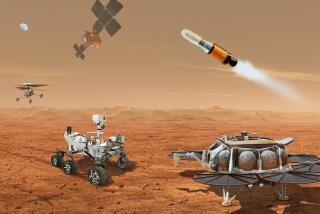Mars Exploration Depends on Joint Missions : Space: In an era of shrinking budgets, scientists say international cooperation is essential. Russia and the United States have shown that such efforts can succeed.
STANFORD, Calif. — Undaunted by deep budgetary problems that face both countries, U.S. and Russian engineers are working together to build new enthusiasm for the exploration of Mars.
Russian scientists from the Babakin Center near Moscow, Russia’s space research headquarters, and their U.S. colleagues from the NASA Ames Research Center, Stanford University and McDonnell Douglas Corp., say joint efforts are the answer to overcome official resistance to exploring Mars.
Mars explorations “are going to be done internationally or they’re not going to be done at all,” said Louis D. Friedman, executive director of the Planetary Society, a Pasadena-based international space advocacy group.
The society is also a partner in the Russian mission to launch orbiters that will carry robotic explorers to Mars in 1994 and 1996.
Garry Rogovsky, deputy director of the Babakin Center, said Russia hopes for increased cooperation with the United States.
The cost of a manned U.S. exploration of Mars has been estimated at between $300 billion and $500 billion over 30 years. However, supporters of the Russian program say unmanned spacecraft will cost a fraction of that.
“Before we can even contemplate (human landings), we need a series of robotic precursors,” said David Morrison, head of space sciences at NASA Ames.
The scientists gathered here recently to show off the Russian prototype of a six-wheeled, triple-axle, camera-equipped robotic vehicle, or rover, that can make maps and take soil samples. Russia intends to use the rovers on the 1994 and 1996 launches.
Congress has appropriated no money in the current fiscal year for manned exploration of Mars, but officials say they believe the public still supports the space program.
Sporting a button proclaiming her membership in the “Mars Underground,” NASA Ames research scientist Carol Stoker said it’s not a question of whether people go to Mars, but when.
“It’s our destiny as a human species to become a multi-planetary and multi-stellar civilization,” she said.
NASA officials at the Ames center who tested the Russian-made robot at their labs in Mountain View said they were impressed.
“Their robotics technology blows my mind,” Stoker said.
The U.S. Mars Observer spacecraft was launched from Cape Canaveral in September, heralding an era of unprecedented U.S.-Russian cooperation in space.
Eleven Russians belong to the science team overseeing the flight of the Mars Observer. On an 11-month, $980-million voyage to the Red Planet, the Mars Observer program is being coordinated at the Jet Propulsion Laboratory in Pasadena.
Once the $500-million spacecraft goes into orbit around Mars, it will map the planet’s geology and climate. It is carrying a French-Russian radio designed to relay data from landing craft.
The Russian orbiters to be launched in October, 1994, and November, 1996, will carry the robot rovers and an experiment-laden balloon. The spacecraft would reach Mars in September, 1995, and October, 1997.
The Mars Observer will greatly increase the amount of data relayed to Earth by the Russian surface armada because it will fly over the landing craft more frequently than will the Russian orbiters.
Another joint U.S.-Russian mission is planned for 1995, when the space shuttle Atlantis is to dock with the space station Mir. However, a recent edition of Aviation Week & Space Technology magazine cited what it called “a power struggle” between civilian and military space planners in Russia and said it could affect the joint program.
It wasn’t until the dissolution of the Soviet Union--long after cooperation began on the Mars Observer project--that former President George Bush signed a space cooperation agreement with Russian President Boris Yeltsin in June, 1992.
Although Bush in 1989 proposed colonizing the moon early in the next century and later sending people to Mars, little progress has been made. The last American astronaut to land on the moon did so in 1972.
Some space and political experts have said they expect the Space Exploration Initiative to be shelved under the budget-conscious Clinton Administration. But others, including the Americans and Russians who met here, said space exploration dovetails with Clinton’s stated emphasis on high technology and converting military technology to civilian use.
The two countries have had mixed results with their Mars missions.
The Soviet Union started launching spacecraft toward Mars in 1960, but more than half its missions were failures. The United States had two failures out of eight Mariner and Viking spacecraft it sent to Mars.
More to Read
Sign up for Essential California
The most important California stories and recommendations in your inbox every morning.
You may occasionally receive promotional content from the Los Angeles Times.










